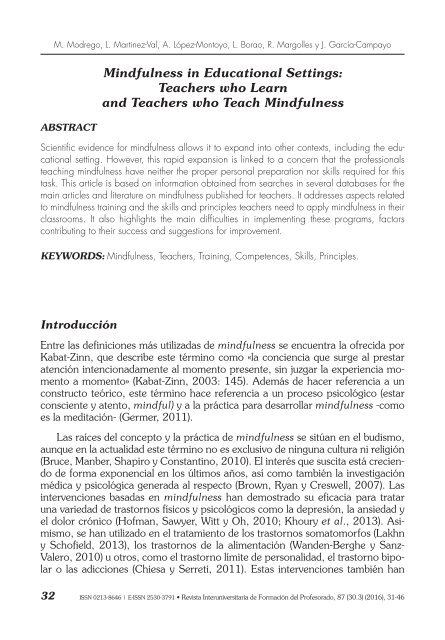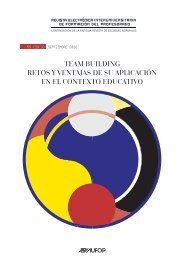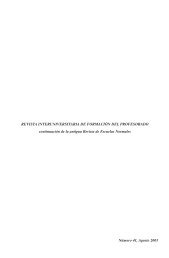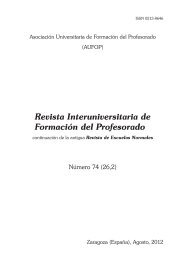Revista Interuniversitaria de Formación del Profesorado
7K1iZyQvx
7K1iZyQvx
Create successful ePaper yourself
Turn your PDF publications into a flip-book with our unique Google optimized e-Paper software.
M. Modrego, L. Martinez-Val, A. López-Montoyo, L. Borao, R. Margolles y J. García-Campayo<br />
ABSTRACT<br />
Mindfulness in Educational Settings:<br />
Teachers who Learn<br />
and Teachers who Teach Mindfulness<br />
Scientific evi<strong>de</strong>nce for mindfulness allows it to expand into other contexts, including the educational<br />
setting. However, this rapid expansion is linked to a concern that the professionals<br />
teaching mindfulness have neither the proper personal preparation nor skills required for this<br />
task. This article is based on information obtained from searches in several databases for the<br />
main articles and literature on mindfulness published for teachers. It addresses aspects related<br />
to mindfulness training and the skills and principles teachers need to apply mindfulness in their<br />
classrooms. It also highlights the main difficulties in implementing these programs, factors<br />
contributing to their success and suggestions for improvement.<br />
KEYWORDS: Mindfulness, Teachers, Training, Competences, Skills, Principles.<br />
Introducción<br />
Entre las <strong>de</strong>finiciones más utilizadas <strong>de</strong> mindfulness se encuentra la ofrecida por<br />
Kabat-Zinn, que <strong>de</strong>scribe este término como «la conciencia que surge al prestar<br />
atención intencionadamente al momento presente, sin juzgar la experiencia momento<br />
a momento» (Kabat-Zinn, 2003: 145). A<strong>de</strong>más <strong>de</strong> hacer referencia a un<br />
constructo teórico, este término hace referencia a un proceso psicológico (estar<br />
consciente y atento, mindful) y a la práctica para <strong>de</strong>sarrollar mindfulness -como<br />
es la meditación- (Germer, 2011).<br />
Las raíces <strong>de</strong>l concepto y la práctica <strong>de</strong> mindfulness se sitúan en el budismo,<br />
aunque en la actualidad este término no es exclusivo <strong>de</strong> ninguna cultura ni religión<br />
(Bruce, Manber, Shapiro y Constantino, 2010). El interés que suscita está creciendo<br />
<strong>de</strong> forma exponencial en los últimos años, así como también la investigación<br />
médica y psicológica generada al respecto (Brown, Ryan y Creswell, 2007). Las<br />
intervenciones basadas en mindfulness han <strong>de</strong>mostrado su eficacia para tratar<br />
una variedad <strong>de</strong> trastornos físicos y psicológicos como la <strong>de</strong>presión, la ansiedad y<br />
el dolor crónico (Hofman, Sawyer, Witt y Oh, 2010; Khoury et al., 2013). Asimismo,<br />
se han utilizado en el tratamiento <strong>de</strong> los trastornos somatomorfos (Lakhn<br />
y Schofield, 2013), los trastornos <strong>de</strong> la alimentación (Wan<strong>de</strong>n-Berghe y Sanz-<br />
Valero, 2010) u otros, como el trastorno límite <strong>de</strong> personalidad, el trastorno bipolar<br />
o las adicciones (Chiesa y Serreti, 2011). Estas intervenciones también han<br />
32 ISSN 0213-8646 | E-ISSN 2530-3791 • <strong>Revista</strong> <strong>Interuniversitaria</strong> <strong>de</strong> <strong>Formación</strong> <strong>de</strong>l <strong>Profesorado</strong>, 87 (30.3) (2016), 31-46










